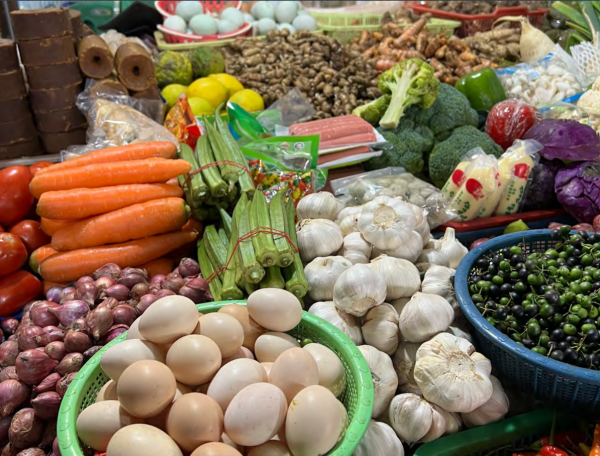Volume Three
A ‘confluence’ speaks to a coming or flowing together, a meeting, or a gathering at one point (of streams, of events, of cultures, of interests, and so on) from which something important often emerges.
From the freshly laid, unwashed chicken eggs and carefully bundled okra to the packaged processed hot dogs and plastic-wrapped vegetables, the cover snapshot reveals a confluence of soil, humanity, seeds, animals, sunshine, water, and time. Taken during a late winter stroll through an Indonesian marketplace, the market and its products serve as symbolic representations of the scholarship collected within the pages of this journal while, concurrently, exemplifying our human-environment interconnectedness and interdependency.
This third issue of the Confluence journal showcases the diversity of academic activities undertaken in the Department of Geography and Environmental Sciences. Faculty members nominated extraordinary student work from their 2023 Fall and Spring semester classes that surpassed standard course requirements. Each nomination underwent a student- and alumni-led peer-review process for publication.
Each piece signifies a confluence of its own, a gathering up of various ingredients (data) combined with the author’s ingenuity and distinctive voice to present their findings in novel ways that nourish us intellectually (research). Three types of creative critical student practices flow into this journal—written papers, multimedia explorations, and cartographic atlases.
Starting with four written papers, the first piece is a literature review written by Emma Tunks that illuminates the impacts of climate change on alpine plant communities. Similarly, Rose Grenen’s brief summarizes the key impacts on aquatic ecosystems from the increased frequency of wildfires throughout the Western United States.
Brooke Safely’s written analysis of morphological changes in the Platte River provides a lesson in transparency when her data reveals no statistical difference. Conversely, Erika Jermé’s report on the demographic and socioeconomic factors for their predictive capacity of access to trees in Denver exposes the complexity of human-environment relationships as expressed through the urban fabric of a city.
Next is the first multimedia exploration with Gretchen Wilson’s video exploring the biogeochemical cycle changes in riverine riparian areas due to urbanization and climate change. The second multimedia exploration from Eric Deakin is the only undergraduate submission in this issue. Eric uses gritty photography to represent the daily relationships and, at times, unnoticed use of natural resources.
The journal closes with four cartographic atlases, each in a unique stand-alone format. An atlas is a thematic collection of maps, charts, and narratives that allows students to engage deeply with a chosen topic. The first atlas is from Mary Straka titled “Clearing the Air: Mapping the Impacts of Pollution in Colorado”. Mary provides a visual understanding of the disproportionate impacts of polluting and hazardous facilities. Next, Jose Puente Puente investigates respiratory illness and environmental conditions in Denver’s neighborhoods, a study that pairs nicely with Straka’s atlas.
Dan Schumacher, a dual Master's degree student in Landscape Architecture and Urban Design, details an expansive new walkability index for Denver neighborhoods. The issue closes with a spatial history atlas by Hannah Larsen that looks at industry along the Detroit Terminal Railroad. Using maps from a private collection, Hannah reconstructed the past to enhance our understanding of existing development patterns in Detroit, Michigan.
Now there is only one thing left to do—dig into the following pages and enjoy!
Sincerely,
Amy DePierre

